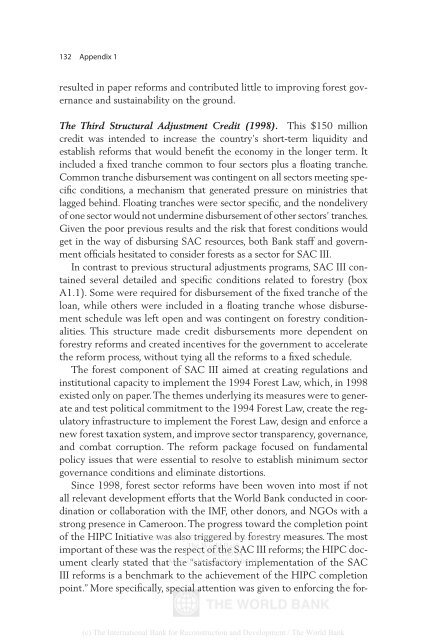The Rainforests of Cameroon - PROFOR
The Rainforests of Cameroon - PROFOR
The Rainforests of Cameroon - PROFOR
- No tags were found...
You also want an ePaper? Increase the reach of your titles
YUMPU automatically turns print PDFs into web optimized ePapers that Google loves.
132 Appendix 1resulted in paper reforms and contributed little to improving forest governanceand sustainability on the ground.<strong>The</strong> Third Structural Adjustment Credit (1998). This $150 millioncredit was intended to increase the country’s short-term liquidity andestablish reforms that would benefit the economy in the longer term. Itincluded a fixed tranche common to four sectors plus a floating tranche.Common tranche disbursement was contingent on all sectors meeting specificconditions, a mechanism that generated pressure on ministries thatlagged behind. Floating tranches were sector specific, and the nondelivery<strong>of</strong> one sector would not undermine disbursement <strong>of</strong> other sectors’ tranches.Given the poor previous results and the risk that forest conditions wouldget in the way <strong>of</strong> disbursing SAC resources, both Bank staff and government<strong>of</strong>ficials hesitated to consider forests as a sector for SAC III.In contrast to previous structural adjustments programs, SAC III containedseveral detailed and specific conditions related to forestry (boxA1.1). Some were required for disbursement <strong>of</strong> the fixed tranche <strong>of</strong> theloan, while others were included in a floating tranche whose disbursementschedule was left open and was contingent on forestry conditionalities.This structure made credit disbursements more dependent onforestry reforms and created incentives for the government to acceleratethe reform process, without tying all the reforms to a fixed schedule.<strong>The</strong> forest component <strong>of</strong> SAC III aimed at creating regulations andinstitutional capacity to implement the 1994 Forest Law, which, in 1998existed only on paper. <strong>The</strong> themes underlying its measures were to generateand test political commitment to the 1994 Forest Law, create the regulatoryinfrastructure to implement the Forest Law, design and enforce anew forest taxation system, and improve sector transparency, governance,and combat corruption. <strong>The</strong> reform package focused on fundamentalpolicy issues that were essential to resolve to establish minimum sectorgovernance conditions and eliminate distortions.Since 1998, forest sector reforms have been woven into most if notall relevant development efforts that the World Bank conducted in coordinationor collaboration with the IMF, other donors, and NGOs with astrong presence in <strong>Cameroon</strong>. <strong>The</strong> progress toward the completion point<strong>of</strong> the HIPC Initiative Delivered was also by <strong>The</strong> triggered World Bank by e-library forestry to: measures. <strong>The</strong> most<strong>The</strong> World Bankimportant <strong>of</strong> these was the respect IP : 192.86.100.34 <strong>of</strong> the SAC III reforms; the HIPC documentclearly stated that Mon, the 09 “satisfactory Nov 2009 17:06:18 implementation <strong>of</strong> the SACIII reforms is a benchmark to the achievement <strong>of</strong> the HIPC completionpoint.” More specifically, special attention was given to enforcing the for-(c) <strong>The</strong> International Bank for Reconstruction and Development / <strong>The</strong> World Bank
















